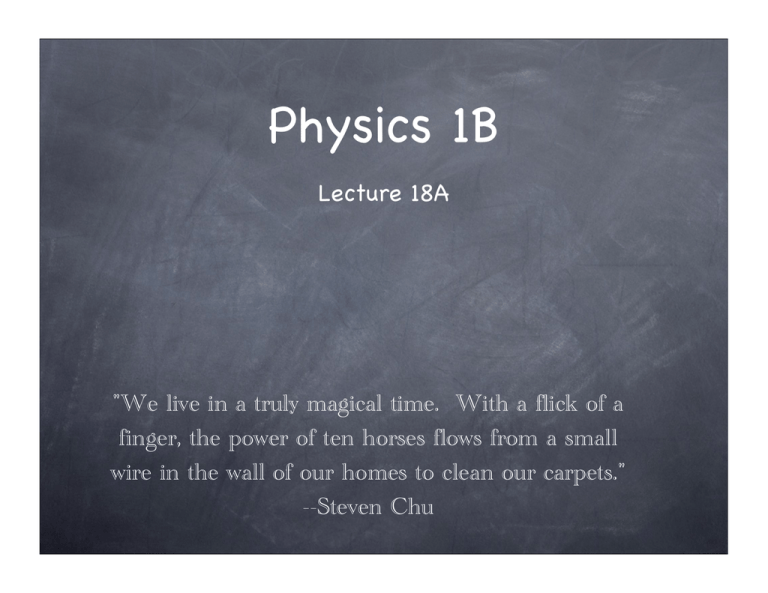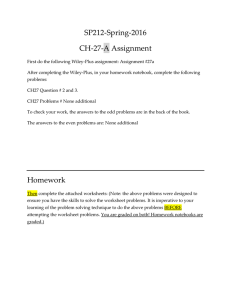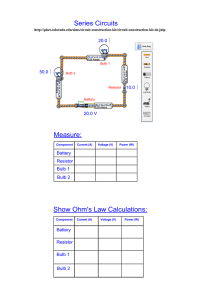Physics 1B
advertisement

Physics 1B Lecture 18A "We live in a truly magical time. With a flick of a finger, the power of ten horses flows from a small wire in the wall of our homes to clean our carpets." --Steven Chu Power Why do electric companies make power lines with very high voltages to deliver electricity to your house? Let’s make some estimations: R = 10Ω, V = 100,000V to deliver 100kW of power. First, don’t make a common mistake: <-no! This equation can only be used with a potential difference (ΔV) across a resistor. Power Instead we will find the current by the power transfer equation. Now we can input this current in the proper power dissipation equations. This only represents a 0.01% loss of power transferred to resistive effects (not bad!). Power What if power companies used lower potential for their transmission lines (say 2,000V)? Now we can input this current in the proper power dissipation equations. 25% of power is lost to heat. That isn’t good business. Superconductors Supercondutors can help solve these problems. Superconductors are materials whose resistance falls to virtually zero below a certain critical temperature, TC. Once a current is set up in a superconductor, it persists without any applied potential difference. Superconductors Above Tc, the superconductor acts as a normal metal. Unfortunately superconductors currently only exist at low temperatures (highest ~150K) [–123oC]. But we are getting closer to room temperature superconductivity. In the mid-80’s the highest was near 30K [–243oC]. Circuits Light bulbs are resistors that you can measure the power dissipated by them with their brightness. The brighter the bulb, the more power dissipation of the light bulb. I have two light bulbs, one 100W and one 60W. If I hook them up separately to the a given battery which one will be brighter? Correct, the 100W bulb was brighter! What if I hook them up in series to the same battery, which one will be brighter then? Conceptual Question I have two light bulbs, one 100W and one 60W. If I hook them up in series to the same battery, which one will be brighter? A) The 100W bulb. B) The 60W bulb. C) They will have the same brightness. D) It doesn’t matter what power rating they have it will always be the one that is closest to the positive terminal of the battery. Circuits The 60W????????????????? Realize that the power rating on light bulbs only represent the power dissipated when they are plugged into the wall. A 100W bulb will not always put out 100W of power dissipation. You have to know what the potential difference source is and what other elements are in the circuit. When examining a circuit you need to know all of the elements in the circuit (think globally). Circuits We will now start discussing how current, resistance, power, and devices work together as a circuit. First, become familiar with the following symbols that make circuit diagrams easy to draw. Batteries There are three basic types of emf: 1) Ideal Battery: a battery that lacks internal resistance. 2) Real Battery: a battery that contains internal resistance, r, that hampers current flow. Note the internal resistance is in series with the battery. 3) Generator: a device that uses mechanical energy to create electrical energy. Circuits A typical circuit problem is to solve for the power/voltage/current at a specific point (like at a resistor). This simplest circuit to calculate the current for is the following: Using Ohm’s Law we find that: ΔV = IR ɛ = IR I = ɛ/R ɛ Circuits Technically, this is the only circuit you can use Ohm’s Law to solve for the current through the resistor. But we can take more complicated circuits and reduce them down this simple circuit and then apply Ohm’s Law. A typical task is to find the current in a circuit and, maybe, then find the power dissipated by various circuit elements. We will use the same ideas that we developed when finding out the equivalent capacitance for a given circuit. Circuits Let’s say we have a circuit with two resistors in series. When these two resistors are hooked up to the battery, a current is then established. In this circuit, the amount of current moving through R1 equals the amount of current moving through R2 (and the same as the battery as well). Ibat = IR1 = IR2 = I Circuits Each resistor will have a voltage drop across it. But the straight part of the wire will not have any potential differences. This means that: ΔVbat = ΔVac The potential difference across either resistor will sum to be the potential difference across the battery. ΔVbat = ΔV1 + ΔV2 Circuits We can essentially replace the two resistors in series with one equivalent resistor. The battery sees current, I, passing through it and believes that the one equivalent resistor has a potential difference of ΔVbat. So, to the battery the equivalent resistance is: Circuits This becomes: The equivalent resistance of resistors in series is greater than the individual resistors. In general, for series resistors: For Next Time (FNT) Finish reading Chapter 18 Start working on the homework for Chapter 18







